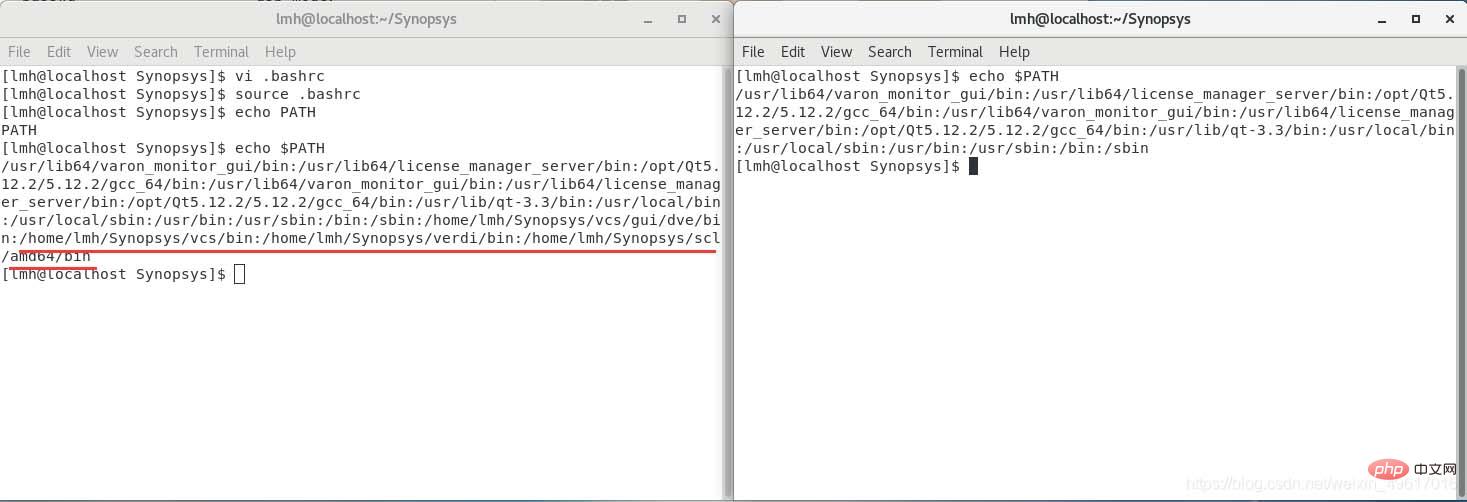安装vcs过程中,csdn上原创或者转载的博主动不动就会说修改.bashrc设置环境变量,有些懒一点的博主甚至直接说在这里我们需要设置环境变量balabala,当时不知道,直接在安装包所在的目录下修改的.bashrc文件,安装成功是成功了,在那个目录下的terminal终端source以后也是可以打开verdi等等vcs套件,但是外部软件调用vcs永远不成功。最后还是归结到环境变量问题上来了。
所以这里先要说明环境变量这个东西,换一种说法,你想在任何路径下调用某路径下的文件,但是总不能每次都要输一大堆路径名,这个时候就要用到环境变量,在相关文件下(下面细说)设置好PATH,也就是环境变量后,就可以不管在哪儿或者哪个外部应用中直接用名称调用(一般合规的名字是不存在冲突的,当然也有同一个软件安装了不同版本的情况会有冲突不过一般会打开默认的那个)。
这里主要讲PATH这种最常见的环境变量的设置,还有LD_LIBERARY_PATH,不过这些清楚他的意思之后就都是差不多的了。
这个PATH和Windows上的PATH是一个东西,你想直接一句verdi打开而不用输路径就在PATH里面加上verdi的路径。
export SynopsysList=/home/lmh/Synopsys export VERDI_HOME=$SynopsysList/verdi export PATH=$PATH:$VERDI_HOME/bin
$有点像指针,除了一些专有名称外自己可以定义一些通用路径名比如VCS_HOME,VERDI_HOME这种,主要都是方便在其他路径里面直接调用了,加上$就表示调用该路径了,直接=是重新定义该路径了,所以PATH定义的时候一定要加上原有的路径$PATH,路径之间用冒号连接。
所以再看这个就明白多了,alias也类似define一样的东西,我在CentOS上是加不加引号单引号双引号都无所谓,最后lmg_vcs都可以激活license。
export SynopsysList=/home/lmh/Synopsys export DVE_HOME=$SynopsysList/vcs/gui/dve export VCS_HOME=$SynopsysList/vcs export VERDI_HOME=$SynopsysList/verdi #dve export PATH=$PATH:$VCS_HOME/gui/dve/bin alias dve="dve -full64" #VCS export PATH=$PATH:$VCS_HOME/bin alias vcs="vcs -full64" #VERDI export PATH=$PATH:$VERDI_HOME/bin alias verdi="verdi -full64" #scl export PATH=$PATH:$SynopsysList/scl/amd64/bin export VCS_ARCH_OVERRIDE=linux #LICENCE export LM_LICENSE_FILE=27000@localhost.localdomain alias lmg_vcs="lmgrd -c $SynopsysList/vcs/license/Synopsys.dat"
这里顺带说一下,一般这种需要自己手动激活的license是需要挂着的,当然也有懒人办法直接修改/etc/rc.d/rc.local文件,在里面加上LD_LIBERARY_PATH的方法,我不懂,老老实实自己手动激活挺好。
bash就是shell的那个bash,CSDN上很多了,随便学,rc就是run command运行指令,字面意思。
还有个.brashrc这个文件我不太懂和这个.bashrc的区别,尝试了一下在.brashrc里面更改PATH并source以后PATH并没有改变,这个网上也没有说这两者区别。

如上图,这个路径下打开shell以后本来是没有vcs等路径的,但是source .bashrc以后再查看$PATH就会显示有vcs的路径,这时候就可以直接输需要输的VCS命令,但是只限于左边这个终端窗口,右边是不行的。
子目录下的.bashrc文件不会预载,不会公用,只针对当前用户的当前终端窗口,每次调用相当于还得自己source一下这个路径下的.bashrc文件才行。有点类似临时环境变量。
所以一般要求设置环境变量的话通用的还是更改~/.bashrc或者/etc/profile
下面阐述一下这两者的区别:
~/是进入当前用户的主目录。即/home/<user_name>路径
.bashrc 是进入.bashrc文件夹,就是用户目录下的名字是.bashrc的目录。
要搞清bashrc与profile的区别,首先要弄明白什么是交互式shell和非交互式shell,什么是login shell 和non-login shell。
交互式模式就是shell等待你的输入,并且执行你提交的命令。这种模式被称作交互式是因为shell与用户进行交互。
这种模式也是大多数用户非常熟悉的:登录、执行一些命令、签退。当你签退后,shell也终止了。
shell也可以运行在另外一种模式:非交互式模式。在这种模式下,shell不与你进行交互,而是读取存放在文件中的命令,并且执行它们。当它读到文件的结尾,shell也就终止了。
bashrc与profile都用于保存用户的环境信息,bashrc用于交互式non-login shell,而profile用于交互式login shell。
系统中存在许多bashrc和profile文件,下面主要区分两种(一般环境变量的设定也只会用到这两种):
/etc/profile此文件为系统的每个用户设置环境信息,当第一个用户登录时,该文件被执行。并从/etc/profile.d 这一配置文件中搜集shell的设置。
~/.bashrc:该文件包含专用于某个用户的bash shell的bash信息,当该用户登录时以及每次打开新的shell时,该文件被读取。
另外,/etc/profile中设定的变量(全局)的可以作用于任何用户,而~/.bashrc等中设定的变量(局部)只能继承/etc/profile中的变量,他们是"父子"关系。
以上就是Linux中怎么修改~/.bashrc或/etc/profile设置环境变量的详细内容,更多请关注php中文网其它相关文章!

每个人都需要一台速度更快、更稳定的 PC。随着时间的推移,垃圾文件、旧注册表数据和不必要的后台进程会占用资源并降低性能。幸运的是,许多工具可以让 Windows 保持平稳运行。

Copyright 2014-2025 //m.sbmmt.com/ All Rights Reserved | php.cn | 湘ICP备2023035733号